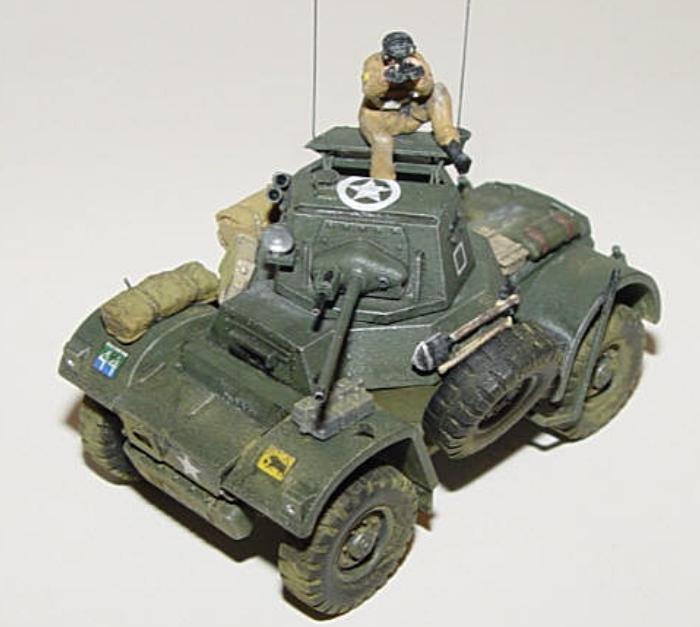Hello folks.
Relic like 'army essence' statements. This is mine for the Brits, a completely new take on the faction that banishes the Men in Trucks of vCoH. It's also sort of modelled on the real-life flavour of the late NW European campaign.
You might wonder: why the Canadian sniper? First, it's Relic (duh) but second this is one of the coolest dudes in WW2 and a direct inspiration:
Sgt. Harold Marshall of the Calgary Highlanders.

Here we go, your thoughts are welcome...
The Commonwealth forces are advancing rapidly across Northwest Europe, adapting doctrine on-the-fly after the breakout from Caen. Gen. Montgomery has issued new doctrinal guidelines giving commanders more discretion and freedom to adapt to circumstances, unleashing his commanders to race east. Their objective: the all-important Rhine Crossings to deny the Germans the industrial heartlands of the Ruhr.
Prior to the breakout the British were hampered by outmoded tactics and the legacy of desert warfare, but now they are catching up fast by adopting Blitzkrieg-style mechanised infantry and armour tactics. The CW forces portray the British and Canadian armies from the period September 1944 to April 1945.
Considerations
• The post-Normandy British put a premium on speed with infantry / armour coordination but still faltered when faced with stubborn German resistance in Arnhem. This was partially due to overly audacious airborne strategy married with logistics problems.
• Formations were comprised of a mixture of veterans and new recruits, from Canada, the conquered European nations and men of ancient British army regiments. The British had also invested heavily in airborne and special operations formations. Elite new units like the Reconnaissance Corps Humber and SAS jeep are hardy light armoured troops. British infantry sections morph into support teams in the field after Command Vehicle upgrades are activated. The base section is modular, able to specialise in infantry, indirect fire or light AT support (Bren / PIAT / 2 inch mortar). Non-specialised rifle teams remain a potent and necessary part of the army though, as support teams can neutralise, but not capture, enemy points.
British infantry are not configured in an AT role, relying on towed, vulnerable AT guns and armour.
• Most armour is medium, cruiser-class models such as Cromwell, augmented by Achilles tank destroyers. Call-in access to Sherman Firefly and the mighty Comet, with its 77mm High Velocity gun is available for mission-specific tasks.
• British doctrine works on the synergy between armour and infantry – a correct matrix of combined arms provides passive bonuses to units working in harmony with one infantry unit ‘twinned’ with a mobile unit. Without this combined arm synergy the Commonwealth can suffer from a too-long ‘logistics tail’ with concomitant penalties to resource income.
• This was an army created to strike deep into territory assaulted by airborne forces and using manoeuvre tactics to exploit advantage. The British are able to convert unconnected points into denial zones by sacrificing resources.
• Air support was plentiful. As a result, British doctrine relies heavily on airborne reconnaissance, air drops and intelligence to make up for the occasional lack of immediate logistical support. British operations can be hampered by strong enemy AA capability.
Army Features
Point denial – spend resources to knock out, but not capture, enemy points. This specialist role is performed by Recce Corps specialists in light Humber ACs, Canadian snipers and SAS jeep squadrons.
Joint Doctrine Synergy – Twin an infantry unit to a vehicle to increase its potency within a small radius. When one of the units is destroyed, the other is penalised until re-twinning with another.
Airborne Operations – Command the mighty British 1st AB Division and the Polish parachute brigade, calling in airborne logistics and elite troops.
Mechanised Infantry – Deploy half-tracks and light multi-role vehicles to support infantry and conduct Blitzkrieg-style strikes deep into enemy territory and screen for your tank-destroying units.
Infantry specialisation – British infantry can convert into support teams in the field, choosing to concentrate on crew-served weapons or rifle sections. Support sections can put boots on the ground and de-cap points but not re-cap them.









 cblanco ★
cblanco ★  보드카 중대
보드카 중대  VonManteuffel
VonManteuffel  Heartless Jäger
Heartless Jäger 